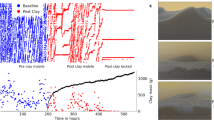Abstract
Hyporheic exchange is often controlled by subsurface advection driven by the interaction of the stream with sedimentary pore water. The nature and magnitude of the induced exchange flow is dependent on the characteristics of both the stream flow and the sediment bed. Fundamental hydrodynamic theory can be applied to determine general relationships between stream characteristics, sediment characteristics, and hyporheic exchange rates. When the stream bed is fine enough to allow application of Darcy's Law, as with sand beds, the induced advective exchange can be calculated from fundamental hydrodynamic principles. Comparison with a wide range of experimental results demonstrates the predictive capability of this theory. Coarser sediments such as gravels are more complex because they admit turbulent interactions between the stream and subsurface flows, which can produce considerable exchange even when the bed surface is flat and no flows are induced by the bed topography. Even for this case, however, scaling arguments can still be used to determine how exchange rates vary with stream and sedimentary conditions. Evaluation of laboratory flume experiments for a wide range of stream conditions, bed sediment types including sand and gravel, and bed geometries demonstrates that exchange scales with the permeability of the bed sediments and the square of the stream velocity. These relationships occur due to fundamental hydrodynamic processes, and were observed to hold over almost five orders of magnitude of exchange flux. Such scaling relationships are very useful in practice because they can be used to extend observed hyporheic exchange rates to different flow conditions and to uniquely identify the role of sedimentary conditions in controlling exchange flux.
Similar content being viewed by others
References
Brunke, M. & T. Gonser, 1997. The ecological significance of exchange processes between rivers and groundwater. Freshwat. Biol. 37: 1-33.
Elliott, A. H. & N. H. Brooks, 1997a. Transfer of nonsorbing solutes to a streambed with bed forms: Theory. Wat. Resour. Res. 33: 123-136.
Elliott, A. H. & N. H. Brooks, 1997b. Transfer of nonsorbing solutes to a streambed with bed forms: Laboratory experiments. Wat. Resour. Res. 33: 137-151.
Eylers, H., N. H. Brooks & J. J. Morgan, 1995. Transport of adsorbing metals from stream water to a stationary sand-bed in a laboratory flume. Mar. Freshwat. Res. 46: 209-214.
Hall, R. O. Jr., E. S. Bernhardt & G. E. Likens, 2002. Relating nutrient uptake with transient storage in forested mountain streams. Limnol. Oceanogr. 47: 255-265.
Jones, J. B. & P. J. Mulholland (eds), 2000. Streams and Ground Waters. Academic Press.
Marion, A., M. Bellinello, I. Guymer & A. I. Packman, 2002. Penetration of passive solutes into a stream bed. Wat. Resour. Res. 38: 1209, doi: 10.129/2001WR000264, 2002, 27-1 - 27-11.
Nagaoka, H. & A. J. Ohgaki, 1990. Mass transfer mechanism in a porous riverbed. Wat. Res. 24: 417-425.
Packman, A. I. & J. S. MacKay, 2003. Interplay of stream- subsurface exchange, clay particle deposition, and stream bed evolution. Wat. Resour. Res. 39(4), 10.1029/2002WR001432: 4-1-4-9.
Packman, A. I., N. H. Brooks & J. J. Morgan, 2000a. A physicochemical model for colloid exchange between a stream and a sand streambed with bed forms. Wat. Resour. Res. 36: 2351-2361.
Packman, A. I., N. H. Brooks & J. J. Morgan, 2000b. Kaolinite exchange between a stream and streambed: laboratory experiments and validation of a colloid transport model.Wat. Resour. Res. 36: 2363-2372.
Packman A. I., M. Salehin & M. Zaramella, 2002. Hyporheic exchange with gravel beds: Basic hydrodynamic interactions and induced advective flows. J. Hyd. Eng., in review.
Salehin, M., A. I. Packman & A. Wörman, 2002. Comparison of hyporheic exchange in vegetated and unvegetated reaches of a small agricultural stream in Sweden: Seasonal variation and anthropogenic manipulation. Adv. Wat. Resour. in review.
Savant, S. A., D. D. Reible & L. J. Thibodeax, 1987. Convective transport within stable river sediments. Wat. Resour. Res. 23: 1763-1768.
Winter, T. C., J. W. Harvey, O. H. Franke & W. M. Alley, 1998. Ground water and surface water: a single resource. USGS Circular 1139.
Wörman, A., A. I. Packman, H. Johansson & K. Jonsson, 2002. Effect of flow-induced exchange in hyporheic zones on longitudinal transport of solutes in streams and rivers. Wat. Resour. Res. 38: 1001, doi: 10.129/ 2001WR000769, 2-1-2-15.
Zhou, D. & C. Mendoza, 1993. Flow through porous bed of turbulent stream. J. Eng. Mech. 119: 365-383.
Author information
Authors and Affiliations
Rights and permissions
About this article
Cite this article
Packman, A.I., Salehin, M. Relative roles of stream flow and sedimentary conditions in controlling hyporheic exchange. Hydrobiologia 494, 291–297 (2003). https://doi.org/10.1023/A:1025403424063
Issue Date:
DOI: https://doi.org/10.1023/A:1025403424063




